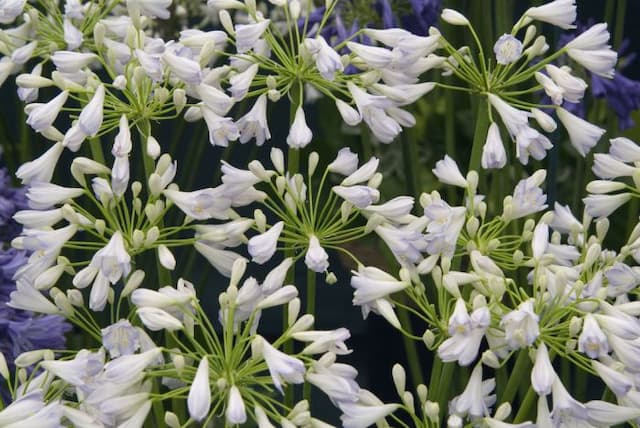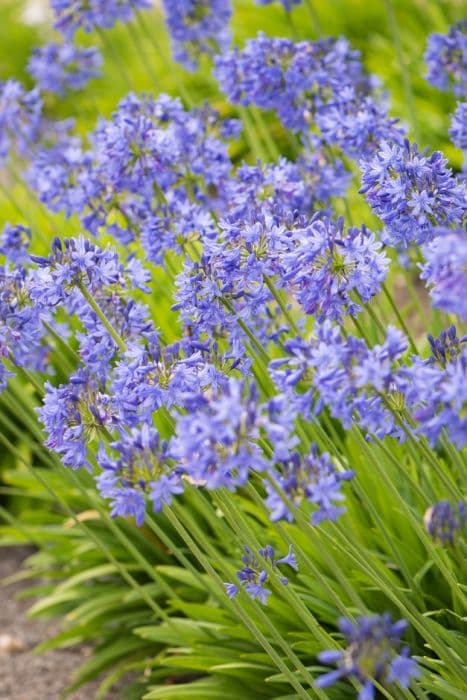African Lily Agapanthus 'Glen Avon'

ABOUT
Agapanthus 'Glen Avon', commonly known as the African Lily or Lily of the Nile, is a striking perennial that is prized for its showy flowers and lush, strap-like foliage. The leaves emerge from the base of the plant, arching gracefully outwards, creating a fountain of green that can add a lush appearance to gardens or landscapes. The most eye-catching feature of the African Lily 'Glen Avon' are its flowers, which explode in round clusters, known as umbels, on top of tall, sturdy stalks that rise above the foliage. Each umbel is a compilation of numerous small, trumpet-shaped flowers. These blossoms are typically a deep, vibrant blue or violet color, which contrast beautifully with the green leaves. The blooms often attract pollinators such as bees and butterflies, adding activity and dynamism to a garden setting. After the flowering period, the plant may produce seed pods, which can add further interest to the plant's profile. The African Lily 'Glen Avon' is not only admired for its decorative flowers but also appreciated for its resilience and low maintenance requirements. It thrives in full sun to partial shade and prefers well-drained soil, making it a versatile choice for a variety of garden designs.
About this plant
 Names
NamesFamily
Amaryllidaceae
Synonyms
African Lily, Lily of the Nile, Love Flower
Common names
Agapanthus 'Glen Avon'.
 Toxicity
ToxicityTo humans
The plant commonly known as Lily of the Nile is considered mildly toxic to humans if ingested. The toxic components can cause symptoms such as nausea, vomiting, and diarrhea. In some cases, it can also lead to dizziness or stupor due to the presence of saponins and glycosides. It's generally advised to avoid consuming any parts of this plant.
To pets
Lily of the Nile is also toxic to pets, such as cats and dogs. If ingested, the plant can cause symptoms including nausea, vomiting, abdominal pain, and diarrhea. Further possible symptoms of poisoning can be drooling, lethargy, or tremors due to the saponins and glycosides present in the plant. Consumption of any parts of the Lily of the Nile should be avoided to prevent these toxic effects.
 Characteristics
CharacteristicsLife cycle
Perennials
Foliage type
Evergreen
Color of leaves
Green
Flower color
Blue
Height
2 feet (0.61 meters)
Spread
1 foot (0.30 meters)
Plant type
Herb
Hardiness zones
8
Native area
South Africa
Benefits
 General Benefits
General Benefits- Ornamental Value: Agapanthus 'Glen Avon', commonly known as Lily of the Nile, boasts attractive, globular clusters of flowers that add aesthetic appeal to gardens and landscapes.
- Drought Tolerance: Once established, Lily of the Nile is relatively drought-tolerant, making it suitable for water-wise gardens.
- Low Maintenance: This plant typically requires minimal care, thriving with just basic watering, occasional feeding, and periodic division.
- Attracts Wildlife: The blooms of Lily of the Nile attract pollinators like bees and butterflies, promoting biodiversity in the garden.
- Long Blooming Season: Offering a long season of bloom, Lily of the Nile provides color and visual interest from early summer to fall.
- Container Gardening: Lily of the Nile can be grown in pots or containers, allowing it to be featured on patios or balconies where ground space is limited.
- Soil Versatility: This plant can adapt to a range of soil conditions, although it prefers well-draining loam, adding to its versatility in different garden settings.
- Erosion Control: The root system of Lily of the Nile can help stabilize soil on slopes, aiding in the prevention of soil erosion.
 Medical Properties
Medical PropertiesThis plant is not used for medical purposes.
 Air-purifying Qualities
Air-purifying QualitiesThis plant is not specifically known for air purifying qualities.
 Other Uses
Other Uses- Photography: The striking blue flowers of the Agapanthus, also known as the Lily of the Nile, can be used by photographers as a natural focal point in garden photography or as a subject for macro photography.
- Art Inspiration: Artists may use the unique form and color of the Lily of the Nile as inspiration for paintings, sculptures, and other creative works.
- Educational Tool: The plant can be used in educational settings to teach students about plant biology, particularly the formation of umbels, a type of inflorescence.
- Dye Source: The flowers of the Lily of the Nile can potentially be used to create a natural blue dye, although this is not a common practice.
- Craft Materials: The sturdy stems and seed pods can be dried and used in floral arrangements and other crafts.
- Garden Design: Used in large, massed plantings, Agapanthus can create a dramatic effect in landscape design with its lush foliage and tall flower stalks.
- Erosion Control: The Lily of the Nile, with its dense root system, can help stabilize soil and prevent erosion in sloped gardens.
- Insect Habitat: The flowers are attractive to bees and butterflies, providing a natural habitat and food source for these beneficial insects.
- Stormwater Management: Agapanthus can be planted in rain gardens where their root systems help absorb excess water and reduce runoff.
- Plant Combinations: The Lily of the Nile can be used to complement other plants in mixed borders or container gardens for interesting texture and color contrasts.
Interesting Facts
 Feng Shui
Feng ShuiThe Lily of the Nile is not used in Feng Shui practice.
 Zodiac Sign Compitability
Zodiac Sign CompitabilityThe Lily of the Nile is not used in astrology practice.
 Plant Symbolism
Plant Symbolism- Love Letters: The name Agapanthus comes from the Greek words 'agape' meaning love, and 'anthos' meaning flower, which suggests it could symbolize a love letter or a message of love.
- Enduring Love: Due to their hardy nature and ability to bloom every year, they can symbolize enduring or long-lasting love.
- Beauty: With its striking blue flowers, Agapanthus is often associated with beauty and attractiveness.
- Fertility: The lush and abundant blossoms of the Agapanthus can symbolize fertility and abundance.
- Home Sweet Home: Often used in domestic gardens and landscaping, the Agapanthus can represent the comfort and beauty of home or domestic happiness.
 Water
WaterLily of the Nile prefers well-drained soil with consistent moisture, especially during its growing season in spring and summer. Water it once a week, providing enough water to soak the soil around the roots deeply. Typically, 1 to 1.5 gallons per plant should be sufficient, but this can vary based on climate and soil type. Cut back on watering during the fall and winter months when the plant is dormant, reducing watering to every other week or less, depending on rainfall. Always adjust watering to ensure the soil is moist but not waterlogged.
 Light
LightLily of the Nile thrives best in full sun conditions, where it can receive at least six hours of direct sunlight per day. Planting it in a spot that gets ample morning sunlight with some shade in the hottest part of the afternoon is ideal. However, the plant can also tolerate partial shade, though flowering may not be as abundant.
 Temperature
TemperatureLily of the Nile can survive in a range of temperatures but prefers warmer climates. It can tolerate minimum temperatures down to about 25 degrees Fahrenheit. Ideally, it flourishes when the temperature remains between 60 and 80 degrees Fahrenheit. Protect the plant from frost to prevent damage to the foliage and roots.
 Pruning
PruningPrune Lily of the Nile after flowering to remove spent bloom stalks and encourage tidy growth. Deadheading the flowers can sometimes stimulate a second bloom. In late winter or early spring, cut back any damaged or dead foliage. Pruning can be done annually to maintain the shape and health of the plant.
 Cleaning
CleaningAs needed
 Soil
SoilLily of the Nile thrives in loamy soil with good drainage, enriched with compost or a balanced, slow-release fertilizer. It prefers a soil pH range of 6 to 8.
 Repotting
RepottingLily of the Nile should be repotted every 3 to 4 years or when it becomes root-bound to encourage healthy growth and blooming.
 Humidity & Misting
Humidity & MistingLily of the Nile prefers moderate humidity but is quite adaptable and can tolerate the humidity levels typically found in most homes and gardens.
 Suitable locations
Suitable locationsIndoor
Place Lily of the Nile in a bright spot with indirect light indoors.
Outdoor
Plant Lily of the Nile in full sun to partial shade outdoors.
Hardiness zone
8-10 USDA
 Life cycle
Life cycleAgapanthus 'Glen Avon', commonly known as African Lily or Lily of the Nile, begins its life cycle as a seed which, when sown in well-drained soil and given proper warmth and moisture, will germinate. The seedling develops into a vegetative state characterized by strap-shaped green leaves, forming a clump from which new growth will emerge. Over time, the plant enters a period of maturity where it produces tall flowering stalks, typically in summer, displaying clusters of funnel-shaped flowers that range from blue to violet. After pollination, these flowers may give way to seed pods if conditions allow, from which seeds disperse, completing the reproductive cycle. During winter or in colder climates, the plant may enter a dormancy period, where growth ceases temporarily. With each growing season, the clump can increase in size as the plant's rhizomatous roots expand, eventually requiring division to manage its growth and rejuvenate its vigor.
 Propogation
PropogationPropogation time
Spring-Early Summer
Agapanthus 'Glen Avon', commonly known as African lily, can be most reliably propagated through division. This method is best carried out in late winter to early spring, just before the active growth season begins. To do this, one would carefully lift the clump of the plant from the ground using a spade, ensuring to get as much of the root system as possible. The clump should then be gently teased apart into smaller sections, each with a portion of the roots and at least one or two growing points. These individual sections can then be replanted into well-draining soil, spaced about 18 inches (approximately 45 centimeters) apart to allow room for growth. Water the divisions well after planting to help establish them, ensuring they receive regular moisture until they are well-rooted and showing signs of new growth.









